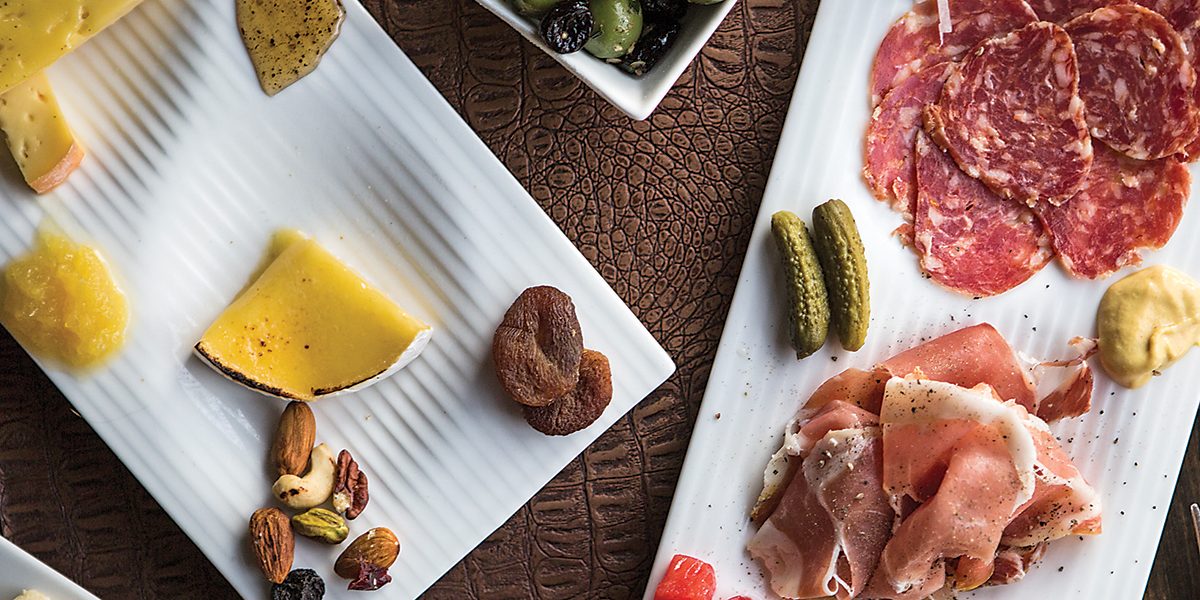Food & Drink
Turning the Corner
A new, funky bar with innovative fare complements its Hampden sibling.
A grittier but gemlike offshoot of the upscale restaurant Corner BYOB
in Hampden, The Other Corner Charcuterie Bar is a near-perfect exemplar
of what a neighborhood bar should be. Slipping into its quirkily rustic
environs one rainy November night (it opened in September), I
immediately felt giddy, as if I’d found the door into a past life or
another country—rural France, maybe, or the rec room of a friend’s
coolest parents, circa 1954. Various cured meats and farm implements
hang over the 14-seat hardwood bar. Tabletops perch on oak barrels
against the far wall, whose crenelated white bricks give the tiny room a
grotto-like feel. A clutch of herbs hangs in a space between the
rafters, beyond which an acid yellow-lit wall boasts a graffito of a
spidery two-faced monkey—a jarring contrast that fittingly sums up the
mix of funk and roughhewn charm. When the
glamorous-as-a-’40s-movie-poster waitress pressed the daily $5 cocktail
into my hands—a hot concoction of artisanal liqueurs and small-batch
rum—I knew I’d died and gone to Hampden heaven.
The place is the
brainchild of BYOB co-owner Bernard Dehaene, whose Belgian roots may be
responsible for the European vibe. A passageway connects the restaurant
to the new bar, so that while BYOB patrons can still bring their own
libations, they can now also order them from the Charcuterie. Meanwhile,
chef Andrew Cole executes a bar menu as funky, charming, and surprising
as the surroundings. Most of the offerings are small plates, reasonably
priced around $7, with one nightly dinner offering for $20, which
includes appetizer, entree, and a glass of wine or beer. Sounds ordinary
enough—the small-plate idea is standard issue—but what plates! At BYOB,
Dehaene is famous for serving up exotic game, everything from wild boar
to yak, and the Charcuterie navigates between beautifully prepared
straight-ahead bistro items (beer-steamed mussels enriched with smoked
bacon and leeks, addictive duck-fat-fried fingerling potatoes, garlicky
escargot), and more adventurous “snacks” like seared frog legs, an
earthy casserole of blood sausage in tomato-garlic sauce, roasted veal
marrow bone, and a mustard-and-crumb-coated pork foot.
That last
is a fine example of the kitchen’s straightforward but magical way with
“parts.” It’s a simple fried pork foot, but as the ethereal breadcrumb
coating yields to the crispy skin and shards of unctuous meat beneath,
you realize it’s addictive and well worth getting a little brutish with
the bones. The housemade “accoutrements” that grace the plate are an
astonishingly delicious array of goodies: slivers of shallot pickled
with curry, jewel-like dabs of port-wine jelly and Forelle pear jam, and
translucent rounds of spicy pickled carrot.
A generously
portioned trio of the eponymous charcuterie—among the choices are hearty
chorizo, creamy mortadella, and Venetian sopressata—comes similarly
accoutred. Accompanied by a crusty baguette and a glass of, say, Saint
Cosme Côtes du Rhône from the bar’s small but reasonably priced
selection of wines, it may be the best $13 meal in town. There are also a
half-dozen artisanal cheeses from near and far to choose from, and
bowls of herb-marinated olives to be had. And there’s a
cognac-chicken-liver mousse that has been flambéed and then swirled into
satiny smoothness with heavy cream. Served with a buttery hunk of
brioche, it is as richly evocative of the French countryside as anything
in Baltimore. If you’re in the mood for a slightly more austere repast,
the house cold-smoked trout with toasted raisin-pumpernickel bread is
tangy and divine.
Of course, it would be a shame to dine here
without sampling one of Charcuterie’s handcrafted cocktails, which hold
equal billing with the food. Using mostly boutique, small-batch liquors,
the bartenders whip up classics like sazaracs and sidecars burnished
with some small fillip of difference: an absinthe-washed glass for the
former, a splash of Elixir Combier in the latter. The daily cocktail
usually features more wildly inventive recipes, but to taste the
difference a craft-distilled liquor can make, a simple Negroni will do.
I
admit that, save for a bite of the Thursday night leg of lamb from a
friend’s plate (delicious), I’ve yet to sample a full dinner at The
Other Corner. (I’ve been too busy making my way through the irresistible
small stuff.) But I’m dreaming of the textural refinements Andrew Cole
might work on the Wednesday night pasta or what rare seasonings he
applies to steak on Saturdays. Rest assured it won’t take me very long
to go back and find out.
